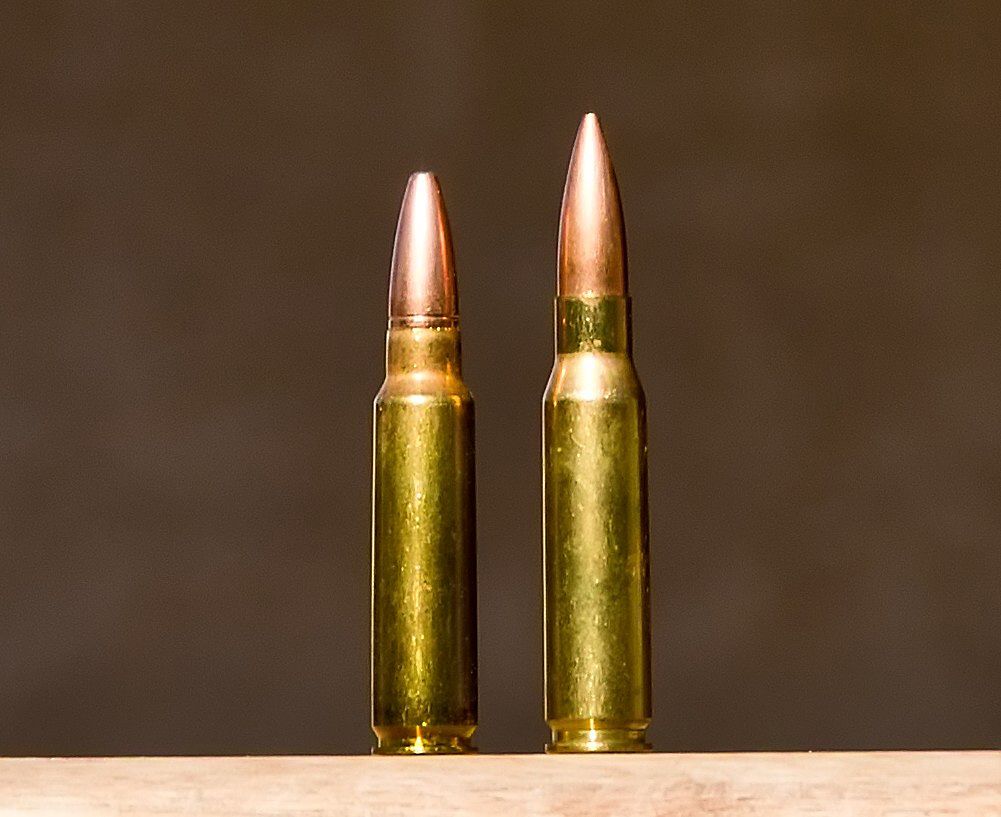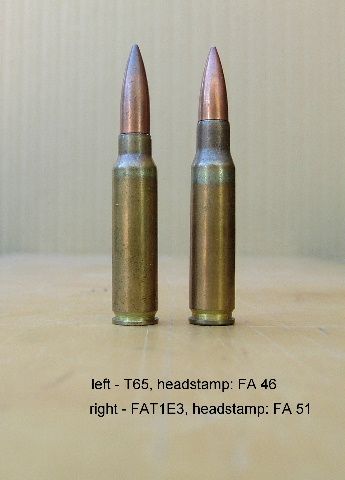During WWII, the U.S. Army was looking to develop a new cartridge that would have nearly the power of the .30-06, but which would be smaller and lighter. They were looking forward to crafting a "light rifle" that would be select-fire - capable of both full and semiauto operation.
In 1944, Springfield Armory was tasked with developing a new weapon, and Frankford Arsenal instructed to develop the cartridge. It was decided that a shortened .30-06 shooting the same bullet with more modern case design and improved powders might work.
In a sense, that cartridge already existed. It was the .300 Savage, which had been developed way back in 1920 as the prime cartridge for the Savage Model 99 lever-action rifle. It was, in fact, a shortened .30-06 - same head size, same .30 caliber bullets.
Frankford Arsenal knew this, and proceeded to buy up a supply of commercial .300 Savage brass from both Winchester and Remington. This brass was used to test for pressure and velocity with different powders and primers.
10,000 modified prototype cases were produced at Frankford for further experimentation. The cartridge was known as the T65. Over next few years, this design went through a number of changes, including neck length, shoulder angle, and case length. In 1949, a final design was approved and called the FAT1E3. Still, more tests were called for, and it was not until August, 1954 that the cartridge was standardized as the 7.62x51mm NATO. In three more years, the U.S. Rifle, M14 was approved and adopted for service.
In 1952, the Army Chief of Ordnance gave Winchester permission to use the FAT 1E3 case commercially. Winchester introduced it as the .308 Winchester that same year, and also debuted the new Model 70 Featherweight rifle. The .308 is today an enduring standard cartridge.
Having recently acquired a Savage 99 rifle and some .300 Savage cartridges for it, I thought it would be interesting to compare the cartridge with a .308 Winchester. You can see the similarities in this picture I took this morning:

Although the headspace dimension is virtually identical, the .308 case has less taper in the body, a more tapered shoulder and a longer neck. Also the extraction groove has been modified to work better with semiauto and full-auto firearms. In this picture, the .300 Savage is loaded with a 150-grain soft point bullet for hunting, and the .308 has been handloaded with a 168-grain Sierra Match King bullet for target use. Interestingly, the velocities are nearly identical at about 2600 fps.
Here's a picture of the Frankford Arsenal developmental cartridges:

As you can see, the T65 case still has about the overall length of the .300 Savage with just a slightly longer neck length - the FAT1E3 is the nearly final 7.62x51mm product.
The .300 Savage cartridge is now obsolete in the sense that arms chambered for it are seldom if ever made now.. Savage lengthened the receiver of the Model 99 to accommodate the later and more prolific .308. Still, many thousands of older Model 99s in .300 Savage are still around, still functional, and still giving good performance right up close to the .308. Both Winchester and Remington still produce ammunition.
Here's the Savage 99 - I don't feel any less armed because it's chambered for a .30 caliber short cartridge developed in 1920!
John

In 1944, Springfield Armory was tasked with developing a new weapon, and Frankford Arsenal instructed to develop the cartridge. It was decided that a shortened .30-06 shooting the same bullet with more modern case design and improved powders might work.
In a sense, that cartridge already existed. It was the .300 Savage, which had been developed way back in 1920 as the prime cartridge for the Savage Model 99 lever-action rifle. It was, in fact, a shortened .30-06 - same head size, same .30 caliber bullets.
Frankford Arsenal knew this, and proceeded to buy up a supply of commercial .300 Savage brass from both Winchester and Remington. This brass was used to test for pressure and velocity with different powders and primers.
10,000 modified prototype cases were produced at Frankford for further experimentation. The cartridge was known as the T65. Over next few years, this design went through a number of changes, including neck length, shoulder angle, and case length. In 1949, a final design was approved and called the FAT1E3. Still, more tests were called for, and it was not until August, 1954 that the cartridge was standardized as the 7.62x51mm NATO. In three more years, the U.S. Rifle, M14 was approved and adopted for service.
In 1952, the Army Chief of Ordnance gave Winchester permission to use the FAT 1E3 case commercially. Winchester introduced it as the .308 Winchester that same year, and also debuted the new Model 70 Featherweight rifle. The .308 is today an enduring standard cartridge.
Having recently acquired a Savage 99 rifle and some .300 Savage cartridges for it, I thought it would be interesting to compare the cartridge with a .308 Winchester. You can see the similarities in this picture I took this morning:

Although the headspace dimension is virtually identical, the .308 case has less taper in the body, a more tapered shoulder and a longer neck. Also the extraction groove has been modified to work better with semiauto and full-auto firearms. In this picture, the .300 Savage is loaded with a 150-grain soft point bullet for hunting, and the .308 has been handloaded with a 168-grain Sierra Match King bullet for target use. Interestingly, the velocities are nearly identical at about 2600 fps.
Here's a picture of the Frankford Arsenal developmental cartridges:

As you can see, the T65 case still has about the overall length of the .300 Savage with just a slightly longer neck length - the FAT1E3 is the nearly final 7.62x51mm product.
The .300 Savage cartridge is now obsolete in the sense that arms chambered for it are seldom if ever made now.. Savage lengthened the receiver of the Model 99 to accommodate the later and more prolific .308. Still, many thousands of older Model 99s in .300 Savage are still around, still functional, and still giving good performance right up close to the .308. Both Winchester and Remington still produce ammunition.
Here's the Savage 99 - I don't feel any less armed because it's chambered for a .30 caliber short cartridge developed in 1920!
John

Last edited:

